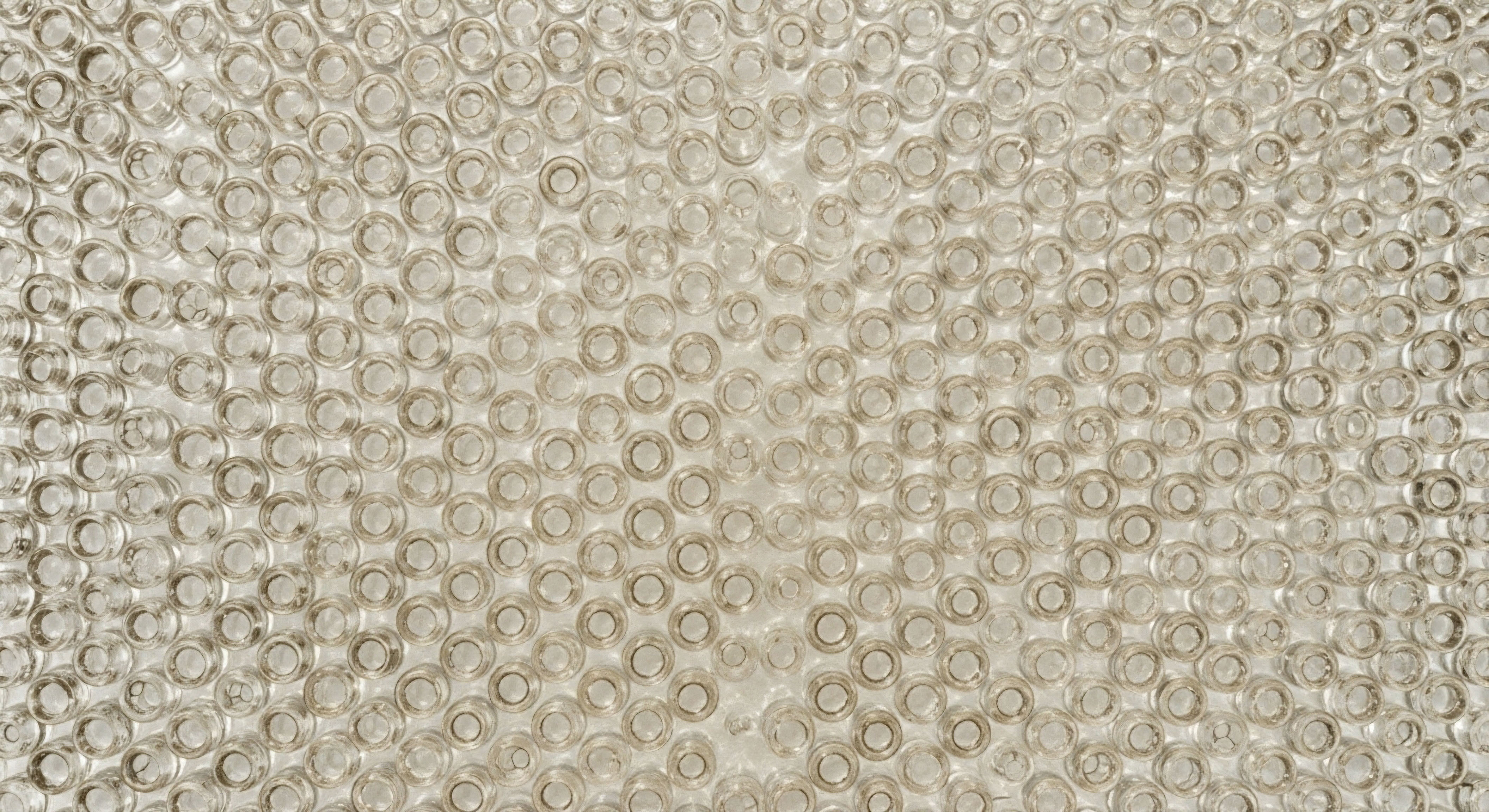

Fundamentals
You may feel that optimizing your hormonal health is a complex, perhaps even mysterious, process. It is common to focus on the therapies themselves ∞ the testosterone, the estrogen, the peptides ∞ as the primary drivers of change. Yet, the food you consume daily holds a profound influence over how your body receives and utilizes these powerful molecules.
The interaction between your diet and your hormonal therapy is a critical dialogue happening within your biology, one that dictates the efficiency and success of your wellness protocol. Understanding this relationship is the first step toward taking control of your physiological narrative.
The journey begins in your digestive system. When you take an oral hormone, such as testosterone undecanoate or estradiol, it must first navigate the intricate environment of your gastrointestinal tract. Its absorption is not guaranteed; it is a process contingent on the conditions it encounters.
The presence of specific dietary components can dramatically alter how much of that hormone actually enters your bloodstream and becomes available to your cells. This concept, known as bioavailability, is central to the effectiveness of any oral therapy. Your diet acts as a gatekeeper, either facilitating or impeding the passage of these hormonal messengers into your systemic circulation.
Your daily food choices directly regulate the amount of hormone your body can actually use from a given dose.
Consider the role of dietary fats. For certain oral hormonal therapies, fats are not just calories; they are essential transport vehicles. Oral testosterone undecanoate, for instance, is formulated to be absorbed through the lymphatic system, a pathway that is significantly enhanced by the presence of dietary fats.
Taking this specific medication on an empty stomach can drastically reduce its absorption, rendering a clinically precise dose almost ineffective. Conversely, consuming it with a meal containing a moderate amount of healthy fat ensures that the hormone is properly packaged and transported, maximizing its bioavailability and allowing your body to receive the intended therapeutic benefit. This illustrates a direct, powerful, and clinically significant link between a specific dietary component and the efficacy of a hormonal protocol.
The conversation extends beyond simple absorption. Your liver is the body’s primary metabolic clearinghouse, responsible for processing everything you ingest, including hormones. The cytochrome P450 enzyme system, a family of enzymes concentrated in the liver, plays a pivotal role in metabolizing and deactivating hormones. Certain foods can either speed up or slow down this process.
This modulation of liver enzymes means your diet can influence how long a hormone remains active in your system, affecting everything from dose stability to potential side effects. The interaction is a dynamic one, where nutrition directly impacts the pharmacokinetics ∞ the journey of a substance through the body ∞ of your hormonal therapy.


Intermediate
Advancing beyond the foundational understanding that food influences hormonal therapy, we can examine the specific mechanisms through which these interactions occur. The dialogue between diet and drug is written in the language of biochemistry, involving enzymatic pathways, transport proteins, and the gut microbiome. A sophisticated approach to personalized wellness requires a grasp of these details, as they explain the variability in patient responses and provide a roadmap for optimizing therapeutic outcomes.

The Critical Role of Lipids in Oral Androgen Absorption
Oral testosterone undecanoate (TU) provides a compelling case study in the necessity of dietary fat for therapeutic efficacy. Unlike other oral medications that are absorbed directly into the portal circulation and subject to immediate and extensive metabolism by the liver (a phenomenon known as the first-pass effect), oral TU is designed to bypass this.
It is a lipophilic (fat-loving) molecule formulated to be absorbed via the intestinal lymphatic system. This pathway is the body’s primary route for absorbing dietary fats.
When you consume a meal containing fats, your body releases bile acids to emulsify them into smaller particles, which are then packaged into structures called chylomicrons. Oral TU hitches a ride within these chylomicrons, which are then absorbed into the lymphatic vessels of the small intestine.
This lymphatic transport system eventually delivers the TU into the general bloodstream, having largely bypassed the liver’s initial metabolic breakdown. Research clearly demonstrates that the amount of fat in a meal directly correlates with the peak serum testosterone concentrations achieved.
While a meal with 30% fat content provides robust absorption, even a lower-fat meal of 20% is significantly more effective than taking the medication in a fasted state. This makes dietary fat an indispensable component of the therapeutic protocol for oral TU.
The specific formulation of a hormone dictates which dietary components are allies in its absorption.

Enzymatic Interactions the Grapefruit Effect
The influence of diet on hormonal therapy extends to the metabolism of hormones, particularly estrogens. The cytochrome P450 enzyme system, specifically the CYP3A4 isoenzyme, is responsible for the breakdown of many drugs, including oral estradiol. Certain compounds found in foods can inhibit or induce these enzymes, thereby altering the drug’s concentration in the body. Grapefruit and its juice are famous for this effect. They contain compounds called furanocoumarins, which are potent inhibitors of intestinal CYP3A4.
When grapefruit juice is consumed alongside an oral estrogen, it effectively slows down the hormone’s metabolism in the gut wall. This reduction in first-pass metabolism means that a larger amount of the estrogen enters the bloodstream, leading to higher-than-intended serum levels.
Studies have shown that grapefruit juice can increase the peak concentration of ethinyl estradiol by as much as 38%. This can amplify the hormone’s effects, both therapeutic and adverse, and may increase risks for certain individuals. This interaction highlights how a seemingly innocuous dietary choice can have significant pharmacological consequences, underscoring the importance of dietary awareness during hormonal optimization.

How Does Dietary Fiber Impact Hormone Excretion?
Dietary fiber adds another layer of complexity to the interaction between nutrition and hormonal balance. Fiber’s primary influence is on the excretion of hormones, particularly estrogens. After being metabolized by the liver, estrogens are conjugated (bound to other molecules) and excreted into the gut via bile for elimination.
However, certain bacteria in the gut produce an enzyme called beta-glucuronidase, which can deconjugate these estrogens, allowing them to be reabsorbed back into circulation. This process, known as enterohepatic recirculation, can elevate systemic estrogen levels.
A high-fiber diet can interrupt this cycle in two ways. First, certain types of fiber, like lignans found in flax seeds, can physically bind to the estrogens in the digestive tract, preventing their reabsorption and ensuring their elimination.
Second, fiber acts as a prebiotic, promoting the growth of beneficial gut bacteria that help maintain a healthy gut environment and can modulate the activity of beta-glucuronidase. By facilitating the excretion of excess hormones, a high-fiber diet can be a valuable tool in maintaining hormonal equilibrium, especially for individuals on estrogen therapy or those with conditions sensitive to estrogen levels.
| Dietary Component | Mechanism of Action | Affected Hormonal Therapy | Clinical Implication |
|---|---|---|---|
| Dietary Fat | Enhances lymphatic absorption | Oral Testosterone Undecanoate | Improved bioavailability; dose effectiveness |
| Grapefruit (Furanocoumarins) | Inhibits CYP3A4 enzyme | Oral Estrogens | Increased hormone levels; potential for side effects |
| High-Fiber Foods | Binds to hormones, reduces reabsorption | Estrogen Therapies | Enhanced hormone excretion; improved balance |


Academic
A sophisticated analysis of how dietary components influence hormonal therapy requires a deep exploration of pharmacokinetics and pharmacodynamics, viewed through the lens of systems biology. The absorption, distribution, metabolism, and excretion (ADME) of exogenous hormones are not linear processes.
They are dynamic events influenced by a complex interplay between the drug’s chemical properties, the individual’s unique physiology, and the biochemical milieu created by their diet. Focusing specifically on the interaction between plant-derived compounds and hormonal therapies reveals a fascinating level of molecular dialogue.

Phytoestrogens and Receptor Modulation
Phytoestrogens are plant-derived compounds with a structural similarity to 17-β-estradiol, allowing them to bind to estrogen receptors (ERs). These compounds, which include isoflavones from soy and lignans from flaxseed, can exert either weak estrogenic or anti-estrogenic effects depending on the endogenous hormonal environment. This dual action is a key aspect of their interaction with hormone replacement therapy (HRT).
In a state of low endogenous estrogen, such as in post-menopausal women, phytoestrogens can bind to unoccupied ERs and exert a mild estrogenic effect, potentially alleviating some menopausal symptoms. Conversely, in a pre-menopausal woman with higher estrogen levels, or in a woman on high-dose estrogen therapy, phytoestrogens can compete with the more potent estradiol for receptor binding.
By occupying the receptor, they can block the action of the stronger endogenous or exogenous estrogen, resulting in a net anti-estrogenic effect. This competitive binding mechanism means that a diet rich in phytoestrogens could modulate the cellular response to a given dose of HRT.
While some studies suggest that a high intake of phytoestrogens does not interfere with the efficacy of HRT for symptom relief, the potential for interaction at the receptor level is a significant area of ongoing research.

What Is the Role of Gut Microbiota in Phytoestrogen Bioavailability?
The biological activity of phytoestrogens is highly dependent on their metabolism by the gut microbiota. For example, the soy isoflavone daidzein can be metabolized by certain gut bacteria into equol, a compound with significantly greater estrogenic activity than its precursor. However, only about 30-50% of the Western population possesses the specific gut bacteria necessary to produce equol.
This variability in gut microbial composition creates a spectrum of responses to dietary soy. An individual’s ability to benefit from the estrogenic properties of soy is therefore directly linked to the state of their microbiome. This has profound implications for understanding how a diet containing phytoestrogens might interact with HRT on a personalized level.
The following list outlines key phytoestrogen classes and their dietary sources:
- Isoflavones ∞ Primarily found in soy products like tofu, tempeh, and edamame, as well as other legumes. Genistein and daidzein are the most studied isoflavones.
- Lignans ∞ Abundant in flaxseeds, sesame seeds, and whole grains. These are converted by gut bacteria into enterodiol and enterolactone, which have weak estrogenic activity.
- Coumestans ∞ Found in sprouts, such as alfalfa and clover sprouts. Coumestrol is the primary coumestan.
The individual’s gut microbiome is a critical variable determining the ultimate biological effect of dietary phytoestrogens.
The interaction between phytoestrogens and hormonal therapies is a prime example of the interconnectedness of diet, microbial ecology, and endocrine function. A clinical protocol that considers only the prescribed hormone dose without accounting for these dietary and microbial variables is incomplete.
For instance, a patient on a stable dose of estradiol who significantly changes their intake of soy or flaxseed might experience a shift in their symptomatic response, not because the therapy has changed, but because the underlying biological context has been altered.
| Compound Class | Primary Sources | Mechanism of Interaction | Potential Clinical Relevance |
|---|---|---|---|
| Isoflavones (e.g. Genistein) | Soy, Legumes | Competitive binding to estrogen receptors | Modulation of HRT effects; symptom relief |
| Lignans | Flaxseed, Sesame Seeds | Metabolized by gut bacteria to active forms | Gut health-dependent estrogenic activity |
| Coumestans | Sprouts (Alfalfa, Clover) | Binding to estrogen receptors | Potential for interaction with estrogenic therapies |
Future directions in personalized hormonal wellness will likely involve a more integrated approach, potentially including analysis of the gut microbiome and dietary habits to predict an individual’s response to both phytoestrogens and prescribed hormonal therapies. This level of precision moves us toward a truly personalized medicine, where therapeutic protocols are designed to work in concert with, not in opposition to, the patient’s diet and unique biology.

References
- Am-In, N. et al. “Dietary Fat Modulates the Testosterone Pharmacokinetics of a New Self-Emulsifying Formulation of Oral Testosterone Undecanoate in Hypogonadal Men.” Journal of Andrology, vol. 33, no. 6, 2012, pp. 1282-90.
- Schubert, W. et al. “The Effect of Grapefruit Juice on the Pharmacokinetics of 17-beta-estradiol and Progesterone in Healthy, Postmenopausal Women.” Menopause, vol. 12, no. 4, 2005, pp. 387-92.
- Monroe, K. R. et al. “The Effect of Grapefruit Intake on Endogenous Serum Estrogen Levels in Postmenopausal Women.” Nutrition and Cancer, vol. 65, no. 5, 2013, pp. 644-51.
- Woclawek-Potocka, I. et al. “Phytoestrogens in Menopause ∞ The State of the Art.” Menopausal Review, vol. 12, no. 2, 2013, pp. 80-8.
- Hooper, L. et al. “Effects of Soy Protein and Isoflavones on Circulating Hormone Concentrations in Pre- and Post-Menopausal Women ∞ A Systematic Review and Meta-Analysis.” Human Reproduction Update, vol. 15, no. 4, 2009, pp. 423-40.
- Ham, J. O. et al. “Associations between Dietary Fiber, the Fecal Microbiota and Estrogen Metabolism in Postmenopausal Women with Breast Cancer.” Journal of the Academy of Nutrition and Dietetics, vol. 119, no. 9, 2019, pp. 1519-30.
- Fletcher, R. J. et al. “The Pharmacokinetics of Oral Micronized Progesterone.” The Journal of Clinical Endocrinology & Metabolism, vol. 84, no. 10, 1999, pp. 3575-8.
- Wenzel, U. et al. “Phytoestrogens and Their Impact on Hormone-Dependent Tumors.” Journal of Steroid Biochemistry and Molecular Biology, vol. 129, no. 3-5, 2012, pp. 167-75.

Reflection
The information presented here illuminates the intricate connections between your plate and your hormonal vitality. It moves the conversation about your health from a passive receipt of treatment to an active, daily participation in your own biological recalibration. The knowledge that a meal’s composition can determine the success of a therapeutic dose is a powerful realization.
It places a significant measure of control back into your hands. As you move forward, consider your own dietary patterns. Reflect on how the principles of absorption, metabolism, and excretion are playing out within your system. This understanding is the foundation upon which a truly personalized and effective wellness strategy is built, a strategy that honors the unique and complex reality of your own body.

Glossary

hormonal therapy

testosterone undecanoate

bioavailability

oral testosterone undecanoate

hormonal therapies

cytochrome p450 enzyme system

pharmacokinetics

personalized wellness

oral testosterone

dietary fat

cytochrome p450

dietary fiber

enterohepatic recirculation

estrogen levels

estrogen receptors

phytoestrogens




